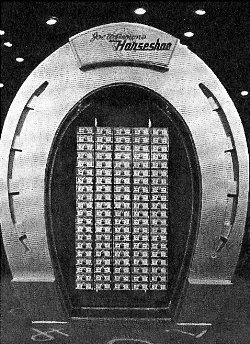HOWARD
HICKSON'S HISTORIES
[Index]
One
Million Dollar Horseshoe
Las Vegas,
Nevada - 1954
Nevada casinos are imaginative when it comes to gimmicks to lure
players in to gamble. The Nugget in Sparks had a near life size gold
rooster on display. It weighed several pounds. The Carson City Nugget
had a large display of gold nuggets greeting customers near the front
door. Reno’s famed Harold’s Club featured a huge collection of firearms.
In Las Vegas, where ideas are bigger and more costly, casinos lure
gamblers with a spewing volcano, magnificent fountains, thundering sea
battles, an Eiffel Tower, New York City buildings, a replica of King
Tutankamun’s burial chamber - the list is long and imaginative. All
this had to start somewhere but it didn’t begin on The Strip where one
upmanship reigns. It happened downtown on Fremont Street in 1954.
Benny Binion, who ran the Horseshoe, had an idea to draw in customers.
He was going to put one million dollars in a display case near the
front door. Benny, with his family, was in Washington, D.C. He saw
people lined up at the U.S. Treasury to see the money there and figured
they might do the same to look at a million dollars in one place, the
Horseshoe. A close friend who had the money, Joe W. Brown, suggested
they display the bills in a golden horseshoe. Brown supplied the notes.
This was just about the time that Benny lost his battle with the feds
and was convicted of tax evasion. He went to Leavenworth Penitentiary
in 1954, where he stayed as a guest of the government until 1957. In an
unusual transaction, he “sold” the Horseshoe to Joe Brown with the
understanding that Binion would again have control when he came back
home to Las Vegas. Brown was now ready to put a million dollars on
exhibit near the front door of the Horseshoe.
Chuck Brooks was supervisor of the loan department at the Bank of
Nevada branch at Fifth (now Las Vegas Boulevard) and Gass Street. He
remembers how the bank came up with the bills. Brown talked to
vice president and manager C.D. Sutherland who ordered 100 $10,000
Salmon P. Chase Federal Reserve Notes from the Denver Mint.
When the money arrived from Colorado, Brown and Robert “Doby Doc”
Caudill* came to the bank. While Sutherland and Brown talked, Brooks
counted the bills in front of Doby, wrapped the money between two loan
application pads, put a rubber band around the packet and placed it in
a cloth money bag. He handed it to Doby who gave it to Brown. Brown
placed it in a suit pocket then he and Doby walked out of the bank.
There were no security guards with them. As they passed by a Salvation
Army donation kettle in front of the bank, the two paused and Joe put a
few bucks in the pot. They continued their walk to the Horseshoe.
Brooks said the whole thing boggled his mind. Whenever he transferred
that much money it was always in the back of an armored truck with
armed guards.
Waiting at the club was a huge horseshoe. It was eight fee tall,
weighed 2,000 pounds and the case to hold the bills was bullet proof.
At the top, on a large plaque inscribed with “Joe W. Brown’s
Horseshoe.”

It was an immediate success. Visitors, to the tune of about
six hundred a day, more or less, had their photographs taken in front
of the million dollar display.
When Brown died, the 100 bills were taken out and put into his estate.
That isn’t the end of the story.
A few years later, Binion decided to put the display up again - people
missed it. He had a hard time finding 100 $10,000 bills but Parry
Thomas solved Binion’s problem. Thomas owned the Las Vegas Bank and
located enough notes at a bank in New York.
In all it’s glory, the gold horseshoe displayed more money than most
people would ever see in their lifetime, This time, the plaque
proclaimed “Binion’s Horseshoe - Las Vegas.”
A few years ago, Chuck Brooks visited the Horseshoe and it was gone. He
asked an older female employee in the money cage what had happened. She
said it had been sold to a collector for $13 million.
* See Doby Doc 1-4 in the index for the story of this unique one of a
kind Nevada character.
Sources: Chuck Brooks, former Las Vegas resident, sent an email to the
author about the bank transaction. His experience gave life to this
vignette. Other information came from
http://gaming.unlv.edu/WSOP/history.html. Author’s personal
knowledge.
©Copyright 2008 by Howard Hickson
* See Doby Doc 1-4 in the index for the story of this
unique one of a
kind Nevada character.
Sources: Chuck Brooks, former Las Vegas resident, sent an email to the
author about the bank transaction. His experience gave life to this
vignette. Other information came from
http://gaming.unlv.edu/WSOP/history.html. Author’s personal
knowledge.
©Copyright 2008 by Howard Hickson
[Back to Hickson's Histories Index]
|
